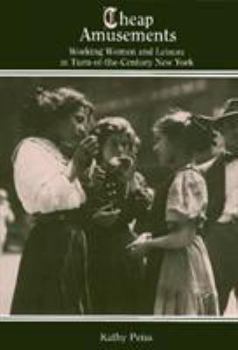Cheap Amusements
Select Format
Select Condition 
Book Overview
What did young, independent women do for fun and how did they pay their way into New York City's turn-of-the-century pleasure places? Cheap Amusements is a fascinating discussion of young working women whose meager wages often fell short of bare subsistence and rarely allowed for entertainment expenses. Kathy Peiss follows working women into saloons, dance halls, Coney Island amusement parks, social clubs, and nickelodeons to explore...
Format:Paperback
Language:English
ISBN:0877225001
ISBN13:9780877225003
Release Date:April 1986
Publisher:Temple University Press
Length:288 Pages
Weight:0.69 lbs.
Dimensions:0.6" x 5.5" x 8.2"
Customer Reviews
5 ratings
How the other half played
Published by Thriftbooks.com User , 20 years ago
In her book, GILDED CITY, M.H. Dunlop chronicled the execesses and outrages of upper class New Yorkers (especially the women of the uppermost uppers) at the turn of the 20th century. While hiding behind the facade that the lavish parties and balls they threw and the exorbitant clothes they had tailored for themselves were giving jobs to the lower classes, their effect was to shamelessly display their wealth and, ultimately, enrage a lower class that was finding the economy and job market less and less bearable. Peiss' style is scholarly yet without the distancing effect that that form of writing usually exhibits in less skilled hands. Her knowledge and passion for the subject are easily identifiable in this wonderful book.Kathy Peiss' CHEAP AMUSEMENTS, for me, is the flipside of the situation. The working women of New York, especially immigrant women, needed some way to spend what little leisure time they had with the little discretionary spending they had. Rather than simply identifying the spots like some old guidebook, Peiss explores each type of simple pleasure ground available to the girls, and how and why they became so popular. On a second level, the book examines the social and sometimes political consequences of this class of working women--bachelorettes--and their spending habits.
Women's Appropriation of Leisure
Published by Thriftbooks.com User , 23 years ago
Peiss begins her argument by explaining the relationship of industrial capitalism to wage labor in creating class-conscious leisure arenas, literally recalling Roy Rosenzweig's study. Peiss's distinction lies in "this conception of leisure did not develop historically in the same way for both sexes." (Peiss, 4). Sexual division ultimately shaped and confined women's leisure to their homes. Thus, the typical wage-earning females in pursuit of leisure were young and single. Their youth and marriage status turned their attentions from the leisurely pursuits of Rosenzweig's working men but to dance halls, amusement parks, and movie theatres. The emerging youth-oriented forms of recreation could not be ignored by the commercial industry, which viewed female participation as lucrative. In addition, these commercialized forms of amusement fostered a heterosocial culture that eventually brought new meanings and restriction to same-sex gender friendships. Rather than stand by and chronicle these changes in leisure for working-class women, Peiss makes the bold argument that these women were actual agents in shaping the nature of their leisure, and Peiss proves again and again to be correct. Even more impressive is her claim that the majority of these women were immigrants or second-generation immigrants (Peiss, 56-88). In examining the actual amusements of working-class women--dance halls, excursions, amusement parks, and the movies, Peiss illustrates vividly how women had a place in the architecture of their own leisure. It is Peiss's conclusion that women's suffrage and the growth of women in the public sphere "infectiously appealed to other middle-class women who were less politicized. Dancing sensual dances, attending cabarets and nightclubs, living as "bachelor girls" in apartment houses, these women expressed a new-found sense of freedom and possibility." (Peiss, 185). Interestingly, the phenomena of entertainment for working-class women eventually made its way to the middle-class, though the "cheap" amusements deliberately shed their vulgarity for the more formal tastes of the middle-class. Although the adventures of the single working-class woman often ceased with marriage, their new leisure pursuits would only grow with consumerism.
The Inner Worlds of the Immigrants You wanted to know.
Published by Thriftbooks.com User , 24 years ago
Cathy Peiss typed written work is a master piece. The inner worlds of the women immigrants are discussed in detail. The book focuses alot on the Jewish, Italian, Irish and Germanic Cycles of people who lived in New York. It explains how immigrant families spent their money on entertainment. You will see real live pictures of the past of commoner citizens. I recommend this book to all [Men AND WOMEN] who wants to know more about the commoner who lived in New York during that time.
An eye opener.
Published by Thriftbooks.com User , 25 years ago
Peiss's work reveals in detail the social implications of young, middle class women's free time in turn-of-the century New York. Based on diaries and reports from the time, Peiss delivers with impact a convincing and highly interesting discussion on how just a few extra hours, a few days out of the week eroded American Victorianism. She writes with authority while keeping her writing very readable.
Excellent!
Published by Thriftbooks.com User , 26 years ago
Better and more interesting than you would think. Peiss delves into the leisure time of young, working women in the industrial age. Definately worth your time.





